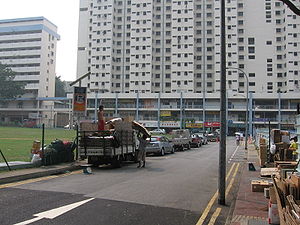
Spring Street, Singapore
Encyclopedia

Street
A street is a paved public thoroughfare in a built environment. It is a public parcel of land adjoining buildings in an urban context, on which people may freely assemble, interact, and move about. A street can be as simple as a level patch of dirt, but is more often paved with a hard, durable...
in Chinatown
Chinatown, Singapore
Singapore's Chinatown is an ethnic neighbourhood featuring distinctly Chinese cultural elements and a historically concentrated ethnic Chinese population. Chinatown is located within the larger district of Outram....
within the Outram Planning Area
Outram, Singapore
Outram is a district in Singapore, within the Central Area, relatively near the prominent city centre and financial districts, but is nearer the border of the Central Area, and outside the Downtown Core. Outram is served by extensive public transport, including SBS Transit and a Mass Rapid Transit ...
of Singapore
Singapore
Singapore , officially the Republic of Singapore, is a Southeast Asian city-state off the southern tip of the Malay Peninsula, north of the equator. An island country made up of 63 islands, it is separated from Malaysia by the Straits of Johor to its north and from Indonesia's Riau Islands by the...
. The street links Neil Road
Neil Road
Neil Road is a one-way road in Chinatown and Tanjong Pagar in the planning areas of Outram and Bukit Merah in Singapore. The road starts at the junction of South Bridge Road, Maxwell Road and Tanjong Pagar Road and ends at Jalan Bukit Merah which then merges into the latter...
to Banda Street
Banda Street
Banda Street is a one-way street located in Chinatown within the Outram Planning Area in Singapore. The road links Spring Street to Sago Street, Sago Lane and Dickenson Hill Road.-Etymology and history:...
and is mainly used during the Chinese New Year
Chinese New Year
Chinese New Year – often called Chinese Lunar New Year although it actually is lunisolar – is the most important of the traditional Chinese holidays. It is an all East and South-East-Asia celebration...
festive season as part of the Chinatown night bazaar.
Etymology and history
The street was once a source of waterWater
Water is a chemical substance with the chemical formula H2O. A water molecule contains one oxygen and two hydrogen atoms connected by covalent bonds. Water is a liquid at ambient conditions, but it often co-exists on Earth with its solid state, ice, and gaseous state . Water also exists in a...
. Spring Street was opposite the Maxwell Market (now Maxwell Food Centre) and got its name from the spring
Spring (hydrosphere)
A spring—also known as a rising or resurgence—is a component of the hydrosphere. Specifically, it is any natural situation where water flows to the surface of the earth from underground...
which fed the well
Water well
A water well is an excavation or structure created in the ground by digging, driving, boring or drilling to access groundwater in underground aquifers. The well water is drawn by an electric submersible pump, a trash pump, a vertical turbine pump, a handpump or a mechanical pump...
there. In the old days, water was drawn and transported by bullock cart
Bullock cart
A bullock cart or ox cart is a two-wheeled vehicle pulled by oxen . It is a means of transportation used since ancient times in many parts of the world. They are still used today where modern vehicles are too expensive or the infrastructure does not favor them.Used especially for carrying goods,...
s at Spring Street.
In Cantonese, the street means the "end of the foreign brothel
Brothel
Brothels are business establishments where patrons can engage in sexual activities with prostitutes. Brothels are known under a variety of names, including bordello, cathouse, knocking shop, whorehouse, strumpet house, sporting house, house of ill repute, house of prostitution, and bawdy house...
s beside the police station
Police station
A police station or station house is a building which serves to accommodate police officers and other members of staff. These buildings often contain offices and accommodation for personnel and vehicles, along with locker rooms, temporary holding cells and interview/interrogation rooms.- Facilities...
".

